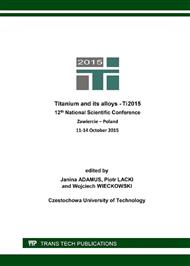[1]
K. E. Oczoś, A. Kawalec, Forming of lightweight metals (in Polish) Scientific Publishers PWN, Warsaw-Poland (2012).
Google Scholar
[2]
M.C. Brandes, M. Baughman, M.J. Mills, J.C. Williams, The effect of oxygen and stress state on the yield behavior of commercially pure titanium, Mat. Sci. Eng. A 551 (2012) 13–18.
DOI: 10.1016/j.msea.2012.04.058
Google Scholar
[3]
G. Purcek, G.G. Yapici, I. Karaman, H. J. Maier, Effect of commercial purity levels on the mechanical properties of ultrafine-grained titanium, Mat. Sci. Eng. A 528 (2011) 2303–2308.
DOI: 10.1016/j.msea.2010.11.021
Google Scholar
[4]
H. Kihira, M. Masaki, H. Shimizu, N. Tagomori, Alumina Blast Titanium for Japanese Traditional Architectures, Nippon Steel Report 85 (2002) 101–106.
Google Scholar
[5]
J. Adamus, Application of titanium sheets in modern building construction. Adv. Mat. Res. 1020 (2014) 9-14.
Google Scholar
[6]
K. Kimura, K. Kinoshita, K. Tokuno, H. Shimizu, Application of titanium to construction, civil engineering and ocean development, Nippon Steel Report, 85 (2002) 6–10.
Google Scholar
[7]
L. Janke, C. Czaderski, M. Motovalli, J. Ruth, Applications of shape memory alloys in civil engineering structures - Overview, limits and new ideas, Mater. Struct. 38 (2005) 578–592.
DOI: 10.1007/bf02479550
Google Scholar
[8]
L. Dieng, G. Helbert, S.A. Chirani, T. Lecompte, P. Pilvin, Use of Shape Memory Alloys damper device to mitigate vibration amplitudes of bridge cables, Eng. Struct. 56 (2013) 1547–1556.
DOI: 10.1016/j.engstruct.2013.07.018
Google Scholar
[9]
G. Song, N. Ma, H.N. Li, Applications of shape memory alloys in civil structures, Eng. Struct. 28 (2006) 1266–1274.
DOI: 10.1016/j.engstruct.2005.12.010
Google Scholar
[10]
Y.M. Parulekar, G.R. Reddy, K.K. Vaze, S. Guha, C. Gupta, K. Muthumani, R. Sreekala, Seismic response attenuation of structures using shape memory alloy dampers, Structural Control and Health Monitoring 19 (2012) 102–119.
DOI: 10.1002/stc.428
Google Scholar
[11]
J. Winowiecka, The analysis of springback of titanium sheet after bending, Metal Forming, 24 (2013) 219–231.
Google Scholar
[12]
J. Adamus, P. Lacki, Forming of the titanium elements by bending. Comp. Mater. Sci. 50/4 (2011) 1305-1309.
DOI: 10.1016/j.commatsci.2010.03.011
Google Scholar
[13]
J. Adamus and P. Lacki, Possibility of the Increase in Titanium Sheets' Drawability, Key Eng. Mat. 549 (2013) 31–38.
DOI: 10.4028/www.scientific.net/kem.549.31
Google Scholar
[14]
J. Adamus, Theoretical and Experimental Analysis of the Sheet-Titanium Forming Process, Arch. Metall. Mater. 54/3 (2009) 705–709.
Google Scholar
[15]
J. Adamus and P. Lacki, Investigation of sheet titanium forming with flexible tool – experiment and simulation, Arch. Metall. Mater. (2012) 1247–1252.
DOI: 10.2478/v10172-012-0139-8
Google Scholar
[16]
P. Lacki, J. Adamus, W. Więckowski, J. Winowiecka, Evaluation of Drawability of Titanium Welded Sheets, Arch. Metall. Mater. 58/1 (2013) 139-143.
DOI: 10.2478/v10172-012-0164-7
Google Scholar
[17]
J. Winowiecka, W. Więckowski, M. Zawadzki, Evaluation of drawability of tailor-welded blanks made of titanium alloys grade 2 || grade 5, Comp. Mater. Sci. 77 (2013) 108-113.
DOI: 10.1016/j.commatsci.2013.04.026
Google Scholar
[18]
P. Lacki, J. Adamus, W. Więckowski, J. Winowiecka, Forming of spherical titanium cups from circular blanks with cutouts on the perimeter, Arch. Metall. Mater. 60 (2015) 829–834.
DOI: 10.1515/amm-2015-0214
Google Scholar
[19]
J. Adamus, Stamping of titanium sheets, Key Eng. Mat. (2009) 279–288.
Google Scholar
[20]
O. M. Badr, B. Rolfe, P. Hodgson, M. Weiss, Forming of high strength titanium sheet at room temperature, Mater. Design 66 (2015) 618–626.
DOI: 10.1016/j.matdes.2014.03.008
Google Scholar
[21]
F. -K. Chen and K. -H. Chiu, Stamping formability of pure titanium sheets, J. Mater. Process. Tech. 170 (2005) 181–186.
Google Scholar
[22]
P. Lacki, K. Wojsyk, A. Słuzalec, The mechanism of failure of the axisymmetrical welded joint under thermomechanical loading, Mater. Sci. Forum, 638-642 (2010) 3805-3810.
DOI: 10.4028/www.scientific.net/msf.638-642.3805
Google Scholar
[23]
J. Winowiecka, P. Lacki, Calculation of the Forming Limit Curve for titanium grade 2 using modified geometry of samples, Computer Methods in Materials Science 15 (2015) 37-43. 15 (2015).
Google Scholar
[24]
P. Lacki, Coupled thermo-mechanical simulation of open die-forging, Computational Fluid and Solid Mechanics 2 (2003) 1394-1396.
DOI: 10.1016/b978-008044046-0.50341-9
Google Scholar
[25]
M. Gierzyńska-Dolna, P. Lacki, Some aspects of modelling of metal forming processes, Comput. Struct. 81 (2003) 605-613.
DOI: 10.1016/s0045-7949(02)00425-x
Google Scholar
[26]
P. Lacki, K. Adamus, Numerical simulation of welding thin titanium sheets, Key Eng. Mat. 549 (2013) 407-414.
DOI: 10.4028/www.scientific.net/kem.549.407
Google Scholar
[27]
W. Piekarska, M. Kubiak, Z. Saternus, Numerical modelling of thermal and structural strain in laser welding process, Arch. Metall. Mater. 57 (2012) 1219-1227.
DOI: 10.2478/v10172-012-0136-y
Google Scholar


